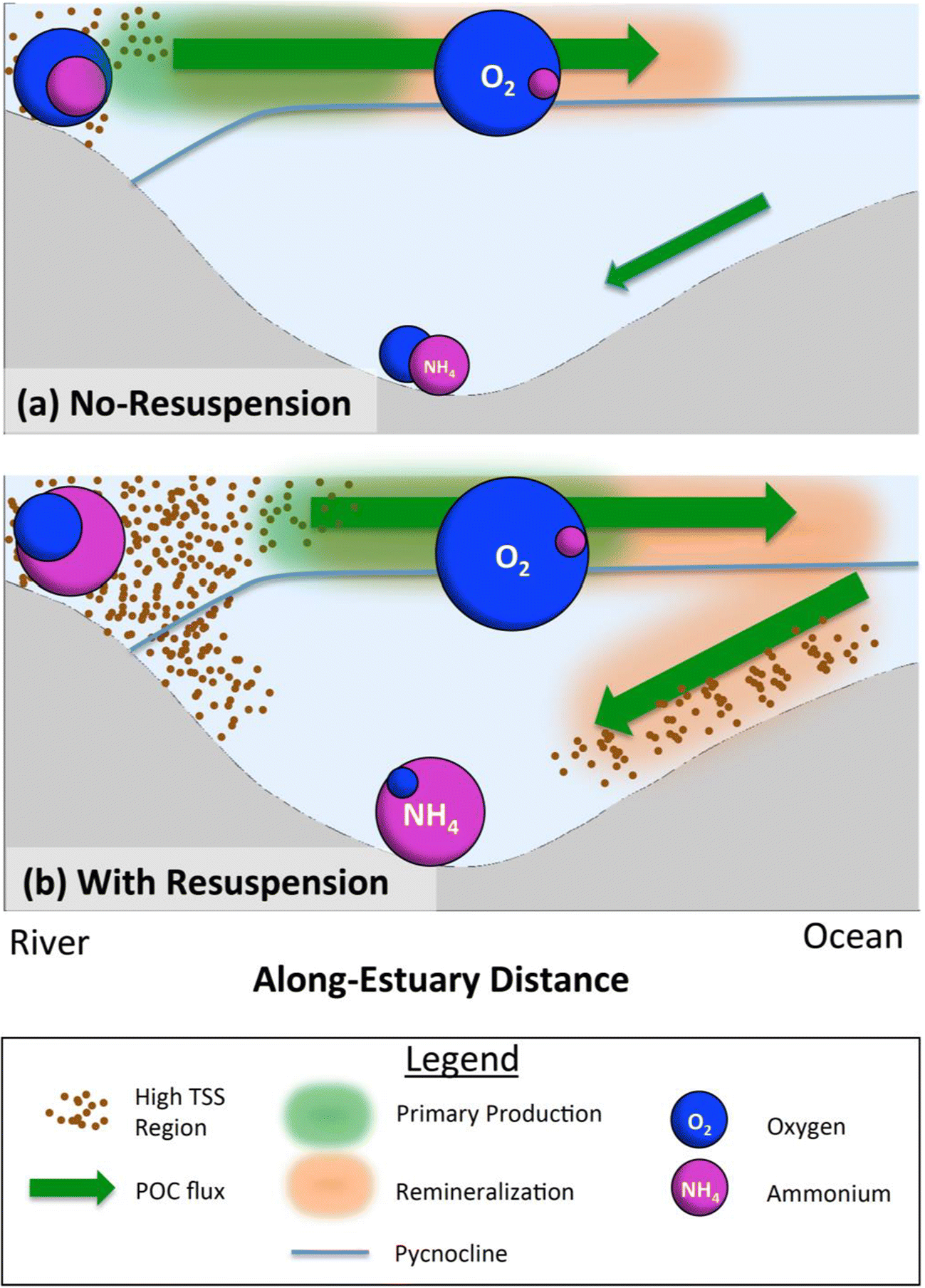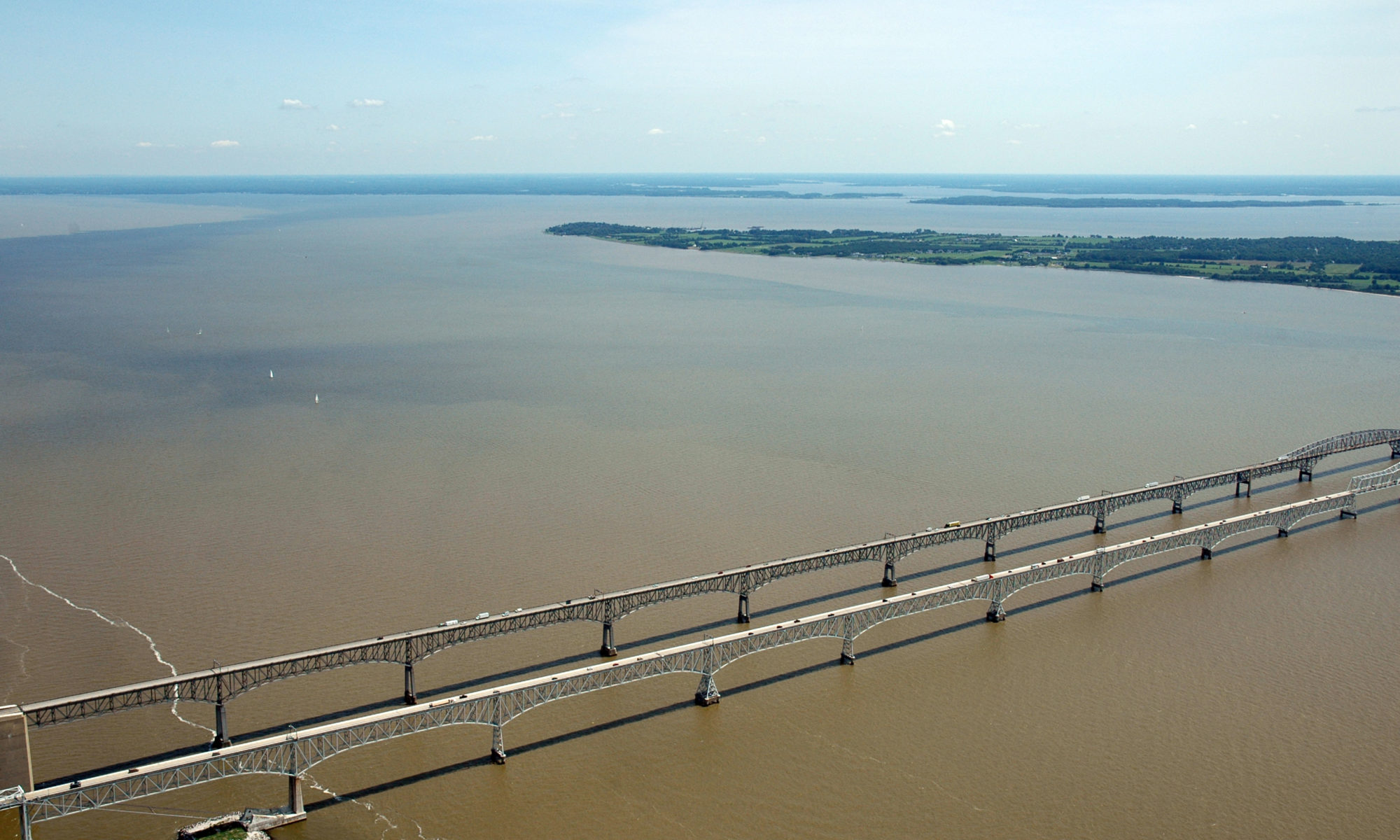Featured Image: Plumes of muddy, sediment-laden water at the Chesapeake Bay Bridge near Annapolis, MD. Photo courtesy of Jane Thomas/ IAN, UMCES.
Paper: Seabed Resuspension in the Chesapeake Bay: Implications for Biogeochemical Cycling and Hypoxia
Authors: Julia Moriarty, Marjorie Friedrichs, Courtney Harris
A memorable feature of the Chesapeake Bay, the largest estuary in the USA, is that the water is very murky and looks like chocolate milk. Former Senator Bernie Fowler has conducted public “wade-ins” over the past 50 years in one of the Bay’s tributaries, seeing how deep the water is before he can no longer see his white tennis shoes, and let’s just say it is never very deep. This is because of the high concentrations of sediment, or small particles of sand and organic material, in the water. Besides making it harder for seagrasses to grow and serving as food for the economically-important oyster, sediment impacts the biological processes that determine how much oxygen and nutrients are available in the water for algae and fish.

Sediment enters the Chesapeake Bay water column either from its 12 major tributary rivers or through resuspension of sediment that has previously settled on the bottom of the bay, increasing the water’s cloudiness. If oxygen is present, then those particles are broken down by microbes who use the oxygen and produce readily usable nutrients. Previous studies show sediment resuspension is important to these biological processes, but none have quantified that impact or looked at the impact of sediment resuspension within different regions of the Chesapeake Bay.
In their recent paper, Moriarty and colleagues used mathematical models to show the effect of sediment resuspension on light availability, algal production, and the degradation of the organic matter within the particles influencing oxygen and nutrients, such as ammonium, concentrations in the water. Both oxygen and ammonium concentrations are important environmental health indicators in the Chesapeake Bay. The researchers simulated water movement, sediment in the water column, and the resulting sediment degradation through chemical reactions facilitated by microbes. By applying their simulations to conditions in the Chesapeake Bay in 2002 and 2003, the researchers compared a year with less than average freshwater discharge to a year with more than average freshwater discharge from the tributaries, respectively.
The simulations produced a multitude of outputs, including patterns of sediment and light distribution, chemical tracers, algal production, and oxygen consumption by biological processes, and were comparable to actual measurements made in the Chesapeake Bay in 2002 and 2003. The simulations captured the low oxygen and high ammonium concentrations in the deep parts of the channel within the main stem of the bay, while simultaneously showing higher oxygen and lower ammonium concentrations in the surface waters. Surprisingly, wet and dry years had similar outputs, with their differences mostly being spatial. By comparing simulations with and without sediment resuspension, Moriarty and colleagues quantified resuspension’s impact as decreasing oxygen concentrations by 25% and increasing ammonium by 50% in the bay.

Theoretically without waves and tides causing sediment to reenter the water column, or with less sediment coming from tributaries, the water column would be less cloudy and improve water quality indicators. However, the effects would not be equal throughout the bay, with a spatially cascading effect. Based on their simulations, Moriarty and colleagues predict a cascade from less sediment resuspension would start with the light-limited algae living in the upper bay growing more, moving the peak in algae abundance north and injecting more oxygen into the water in the upper bay. Therefore, fewer nutrients and more sediment from dead algae would be exported downstream to the lower bay. Then in the lower bay, less algal production and the decomposition of dead algae from the upper bay would lead to lower oxygen concentrations. From the varying spatial impact that reducing sediment had in their simulations, the researchers suggest that management decisions need to take into account how all the different parts of the Chesapeake Bay, and other sediment-driven estuaries, will respond to changes in sediment dynamics.

Muddy waters lead to decreased oxygen in Chesapeake Bay by Hadley McIntosh Marcek is licensed under a Creative Commons Attribution-ShareAlike 4.0 International License.

